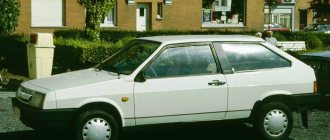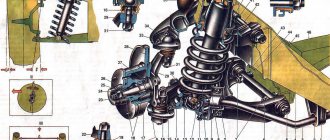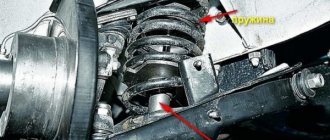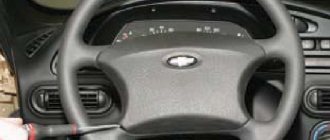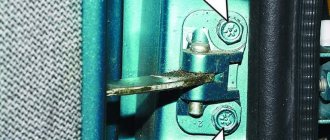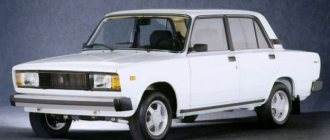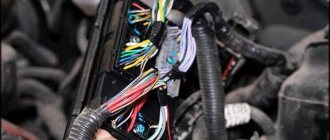Removing the lever, replacing silent blocks
We remove the lever from the car to replace it, as well as to replace the silent blocks of the lever.
The work is shown on the right lever; the left lever is removed in the same way. Disconnect the ball joint from the lever (see “Removing the ball joint”). Unscrew the nut securing the brace to the front suspension arm and remove the washer (see “Removing the brace”). We unscrew the nut of the bolt securing the stabilizer bar to the lever and remove the bolt (see “Removing the stabilizer bar”). Using a 19mm socket, unscrew the nut of the bolt securing the lever to the body, holding the bolt with a wrench of the same size. When removing the right lever, it is not possible to completely remove the fastening bolt due to the small gap between the bolt and the wheel drive shaft. That's why…
...resting a powerful screwdriver or mounting blade against the body, press the drive shaft together with the shock absorber strut and fist... ...and use a soft metal drift to knock out and remove the bolt.
We remove the lever from the bracket...
...and take it out by removing it from the rear end of the stretcher. When removing the left suspension arm, there is no need to press down the wheel drive shaft.
To replace the silent block of the lever, we press it out in a vice with tool heads or pipe sections of a suitable size. We wet the new silent block with soapy water and press it into the lever.
We knock down the silent block of the extension with a chisel. Having removed the silent block on one side of the lever, we similarly dismantle the silent block on the other side.
We pre-press new silent blocks in a vice...
...and finally press it, striking a punch with a diameter of 8 mm through three windows in the rubber layer. Install the lever in reverse order. We tighten the threaded connections of rubber-metal hinges in the “vehicle on wheels” position. After installing the lever, it is necessary to check and, if necessary, adjust the wheel alignment at a special stand - at a service station.
Design of the standard rear suspension for Priora
Bushings are welded on the front ends of the arms that the suspension has. Silent blocks are pressed into these bushings. Silent blocks are rubber-metal hinges. The bolts that connect the suspension arms to the brackets pass through the silent blocks and are attached to the side members of the car body.
The rear suspension is equipped with hydraulic shock absorbers. The hydraulic shock absorber is installed using a bolt to the suspension arm bracket. The shock absorber rod is attached to the upper spring support using rubber pads and a support washer
Increasingly, car enthusiasts are turning their attention to the rear suspension, which is structurally different from the standard rear suspension of the car.
Lifehack: rear beam of a Priora car, main faults, replacement
Budget cars use a rear beam instead of an independent suspension; the Priora is mounted on a beam at the rear. This massive part is attached to the body on hinges. To make the car more stable, a rear beam stabilizer is provided. It is attached through the stabilizer bushings. There is also a front beam, it is attached to the body and holds the front suspension. These parts are powerful and massive, but even they can break. As the mileage progresses, the silent blocks of the front and rear beams will need to be replaced. The price of spare parts is from 3000 rubles and above. A new part on a Priora costs more than a tenth. But this is mainly marketing. Priora's spare parts are dozens more expensive, although many of the spare parts are the same. The silent block of the rear and front beams can be changed due to wear and due to accidental displacement - when the car gets into an accident, the beam shifts. Good drivers keep everything in their car safe and clean: this applies to the body, chassis, engine, and small details. It is worth periodically checking the suspension of the Lada Priora car - during trips, it experiences considerable load due to poor road surface. At the same time, attention is paid to small components and large ones such as the rear and front beam. All the suspension parts are actually attached to it, which allows the car to move, brake, and confidently overcome obstacles. It must be strong and “hardy” - that is, it must withstand many kilometers before the first malfunction appears. However, a part on a Priora sometimes has to be changed ahead of schedule.
The rear beam can be very damaged due to falling into a deep hole on the road surface, which can “overwhelm” the entire suspension while driving. An emergency situation can occur even after an unsuccessful accident. You can replace it yourself, just understand the complex process and prepare everything you need.
Installing rear independent suspension on a car
How to replace front control arm silent blocks
When operating a vehicle on which a standard rear suspension is installed, the vehicle beam shifts towards the arch when cornering by approximately 1 cm. If the vehicle is equipped with a rear independent suspension, then such a beam displacement is not observed under similar operating conditions. The rear independent suspension is attached rigidly to the body, without using silent blocks in mounting the rear suspension on the Priora, which avoids lateral displacement of the beam.
Silent blocks, which are part of the design of the rear and front suspensions, perform the function of damping all torques and bending moments that may occur during movement, thereby ensuring a stable position of the vehicle on uneven road surfaces and when turning.
Silent blocks are mounted on a car as an element of the chassis and suspension, since this structural element is one of the most reliable and economical ways to prevent the influence of various types of deformations and loads that can occur during the operation of the car on the car body. Installation and replacement of silent blocks on Priora is provided for in some vehicle suspension components:
Basic faults
A beam can fail for two reasons:
- displacement from place;
- mechanical damage (most often a crack).
When a crack occurs in the lever, the torsional rigidity of the body decreases. This parameter determines the degree of safety, as well as the position of the parts. The fact is that with normal body rigidity, which is laid down during design and obtained after the final stage of car assembly, absolutely all components and assemblies (down to the bolts) are in place, they have a maximum permissible vibration amplitude. For example, the suspension “swallows” potholes - the parts actively move, and people in the cabin may not even notice the rolling.
If you increase the torsional rigidity of the body by adding lateral and longitudinal stability beams to the car, nothing bad will happen - the amplitude of vibrations will decrease, a pleasant plus will be the fact that the vehicle will become quieter, there will be less rattling. When the torsional rigidity of the body decreases, there may not even be any talk about comfort.
In addition to the fact that you will most likely have to get used to unpleasant sounds, there will be increased wear and tear on small parts. When a lever cracks, everything that is attached to it begins to move with greater amplitude. The problem is temporarily solved by welding, but this only postpones the solution to the problem for some time. Craftsmen recommend changing the beam.
Mechanical damage manifests itself in the connection of metal with rubber in the Priora levers - when wear reaches its climax, the rubber cracks and peels off. Because of this, a knock occurs in the front and rear suspension, and the car wobbles along the road.
Changing the front beam
For work, prepare two keys 17, 19, 24, WD-40 lubricant, and a ball joint remover. Removing and installing the front suspension arm in the following order:
- Place the car over the inspection hole. You can install the front of the car on stable supports.
- Secure the car with the handbrake.
- Remove the wheels. To do this, moving in a circle, gradually loosen the bolts, and then smoothly pull the wheel towards you, accepting it.
- Coat the threaded connections of the lever with WD-40.
- While holding the bolt securing the stabilizer bar to the lever, do not allow it to turn. Smoothly unscrew the fastening nut and remove the bolt.
- Holding the extension from turning with a wrench, unscrew the nut securing it to the beam.
- Remove the washer gasket.
- Unscrew the ball joint bolt and press the ball joint pin out of the beam.
- While holding the spring washer bolt from turning with a wrench, remove the nut that secures the washer to the lever.
- Smoothly remove the end of the lever from the body bracket.
- Remove the beam from the brace.
- Remove several washers from the guy and mark them so that when installing, put them in the same order.
- Inspect the part for damage: as it wears, the rubber will bulge, crack, and possibly peel off from the metal.
- If it is necessary to replace the silent blocks of the front beam of the Priora, unscrew the bolt securing the front silent block with a 18mm socket. The rear mounting bolts are unscrewed with a 15mm socket.
- Remove the silent block, noting its seating depth. Place the new part in place of the old one in strict accordance with the marked depth.
- Install a new lever. Place the washers in the marked order, with the same side in relation to the center of the part with which they were installed previously. Please note that the final tightening of the connections is carried out after the car is lowered to the ground.
Garage or service station
All car owners can be divided into two categories:
- Those who carry out most of the repairs themselves in their garage, and only in emergency cases turn to a car service;
- Those who prefer not to touch anything with their own hands, but completely entrust repairs and maintenance to the masters of service stations.
Each of them is right in their own way. Therefore, we have no right to reproach those who do not want to carry out repairs themselves. After all, garage and professional repair of silent blocks, like other components, has its advantages.
STO has the following advantages:
- A high-quality, responsible car service provides a guarantee for repairs performed;
- In the event of a repeated breakdown covered by the warranty, repairs will be carried out free of charge;
- Professionals are professionals; they have extensive experience and knowledge, which allows them to competently perform their work.
But first you need to find such a car service, which, alas, is not an easy matter. Many provide a guarantee, but when you re-apply, they do everything possible to prove that the breakdown does not comply with the terms of the guarantee. A banal trick.
Repairing your garage will provide the following advantages:
- Significant financial savings, since you only have to spend money on consumables;
- The quality of the work performed by a master is always in doubt if you do not know this person personally. So self-repair may be much better than at a service station;
- You purchase the silent block, and the master only installs it. Why pay money for work that you can do yourself?!;
- Guarantee that a new one will be installed instead of the old silent block. Questionable service stations can easily install an old, more or less usable silent block instead of the one you gave them. You know what the result is.
Changing the rear beam, how to remove it
- Replacing the rear beam on a Priora begins by raising the car using a lift, or you can raise the rear part by placing a jack under the lever. For work, prepare a pressing tool, wrenches 15, 19, 10 - the latter will be useful for unscrewing the brake pipe nuts.
- Remove the wheel.
- Remove the rear suspension shock absorbers.
- Disconnect the parking brake cables from the equalizer and remove them.
- Remove the cable sheaths from the bracket attached to the body. Take out the cables themselves and you will see the bolt securing the beam.
- Disconnect the fasteners for the elastic lever of the pressure regulator drive from the bracket on the lever.
- Remove the brake hoses one at a time, immediately closing the holes.
- Remove the nuts securing the lever to the brackets. Before removing the lever, knock out the bolts.
- When taking the lever with your partner, place it in a dry place. Despite the factory’s recommendations, it is recommended to leave the brackets on the body. After prolonged use, the bracket studs have become acidic and may break, so it is better to keep them in place.
- Place a new part in place of the old one and assemble the suspension in the reverse order.
- If you need to replace the silent blocks of the Priora rear beam, use a press out tool to remove the old parts, noting the depth of their installation, and put new ones in their place.
- For a car, a torsion bar is installed directly from the factory. But for better stability of the rear suspension, you can additionally install a stabilizer - this increases the torsional rigidity of the body, creates a more “dense” pressure exerted in relation to the car parts, preventing them from becoming unnecessarily loose when moving.
Set of parts for mounting the air suspension of Lada Priora
The independent suspension on the Priora is installed on the car yourself, and the installation process is simple. Therefore, every car enthusiast can install air suspension on a Priora if you follow certain tips and recommendations from experts.
In the process of pumping compressed air into the airbag, the ground clearance of the Lada Priora changes. When the pressure in the air bag decreases, the ground clearance of the vehicle decreases. Adjusting the ride height is the main function of the Priora suspension airbag.
An independent suspension is mounted on the Priora using special fasteners and braces. Using these elements, the Lada Priora air suspension is attached to the car body. If you have some skills in working with metal, you can make these parts yourself, but it is best to order these fastening components for the Priora suspension and make them from a specialist. In this case, there will be a guarantee of high-quality manufacturing of components.
To install it in the suspension system on a Priora, you can use the same pressure gauge that is used in pneumatic systems operating at a pressure of a certain range. The start button is designed to adjust the state of the air suspension directly from the interior of the Lada Priora.
Easy replacement of the front suspension arm silent block
When repairing the chassis of front-wheel drive cars of the VAZ family (Samara, Priora, Kalina, Grants), quite often there is a need to replace the silent blocks of the front suspension arms. And if there are usually no problems with replacing the rear hinge of the extension (chamomile), an ordinary hammer and chisel is enough. There are many difficulties with pressing out and pressing in the silent blocks of the lever.
The easiest way is to take the car to a service station, pay the money and not worry about it. But, if you are reading this material, then most likely you will be doing the replacement personally and you want to do everything cheaply, with high quality and without extra effort.
What kind of tricks are not used:
- buy new levers with already pressed silent blocks and daisies (a rather low-budget option);
- they take their removed levers to a service station, where they change the silent blocks with a press;
- grind/buy various pullers;
- They are trying to make a replacement using improvised means.
All options are working and you can use whichever one you consider the most problem-free in your situation. I’ll tell you about a way to replace the silent blocks of a lever without much expense or effort, but you’ll have to prepare a little.
So, in addition to the usual tools, we will need:
- Old front wheel bearing from Samara, Priora, Kalina or Granta. If you have been repairing your car yourself for several years, then most likely you already have it lying around somewhere. If not, then you can ask your neighbors in the garage, friends, and finally, at any car service center. Its cost is close to zero, so it will be given to you without any problems at one service or another.
- Long bolt with nut. Preferably hardened, it will last longer. 15 centimeters long, 12 mm in diameter. There should be as many threads as possible. For our purposes, you can take a cylinder head bolt, classic suspension bolts, or in general any suitable bolts.
- A pair of thick washers with a central hole for our bolt, one with an outer diameter of at least 40 mm, the second with a diameter of up to 30 mm.
- Silicone grease or soap solution (or dishwashing liquid).
How to change daisies on a Priora
If your car pulls to the side on small bumps in the road, or when you press the accelerator pedal, the car tries to go to the right or left, but not straight, the cause may be wear on the silent blocks of the front control arms. They are made of rubber-metal and serve to:
- Keep the wheel from moving longitudinally
- Smooth out road irregularities transmitted to the car body
In this article we will tell you how to replace the silent blocks of the front suspension arms on Kalina.
To ensure that replacing the silent blocks on the levers with your own hands does not cause any inconvenience, we jack up the front part of the car and remove the front wheel. It will be even more convenient to drive the car into a pit, then you won’t have to remove the wheel - it won’t interfere. If you use a lift, you also do not need to remove the wheel. After such a little preparation, replacing the silent blocks of the front control arms on a VAZ will take place without any particular difficulties.
Let's pre-treat the assembly with WD 40 to make it easier to unscrew the rear trailing arm nut, then unscrew it with a No. 24 wrench. The nut may become strongly stuck and therefore will not be unscrewed. In this case, a lot of force may be required. You may even need to heat the nut with a gas torch.
We unscrew the front fastening of the lever to the body with head No. 17.
We take out the trailing arm from the silent block of the transverse arm. Be careful - the shims on the trailing arm must remain in place (if any).
There are two silent blocks in one lever; they are inserted from the outside - on one side and the other. We remove the silent blocks from the transverse arm. They may fall out on their own, or they may rust the outer metal ring to the lever. Then you will need a hammer and chisel to knock them out.
We take new silent blocks. We press them into the hole in the lever.
Thanks for subscribing!
Now we insert the trailing arm into the new silent blocks; it is advisable to lubricate the threaded part with graphite grease or grease. We screw the front lever mount to the body and tighten the rear lever mount nut. That is, we collect everything in reverse order.
Repeat the same steps on the second side, if necessary.
Simple preventive measures will help you save silent blocks, as well as the suspension as a whole, for longer. For information on how to diagnose failed silent blocks, read the article “Diagnostics of silent blocks of front wishbones”.
After replacing the struts, supports, steering and ball bearings, the knocking noise when driving on uneven roads did not disappear
And then the other day I crawled under the car and noticed the damaged silent blocks
I went online to see how this whole thing is changing and someone on Drive found a post about replacing silent blocks and rubber bands, or popularly known as “Daisies.” After studying the material, I finally decided to change them.
Pressing out the silent block
To press out the old silent block, you need to cut off the rubber side on one side. You can cut the rubber with a simple knife, or you can cut it down with a hacksaw. Then, through any suitable iron spacer, we simply knock the silent block out of the lever. You need to hit it hard, preferably with a sledgehammer, don’t be afraid, you won’t break anything. In the picture below there is already a knocked out silent block with a cut off side.
Instead of a sledgehammer, you can use a heavy-duty vice if you have one. You can burn the rubber with a blowtorch or gas torch. You can drill several holes in the rubber and then knock out the weakened silent block. All options are working, choose the one that is more convenient for you. But, as a rule, just knocking it out is faster and easier (necessarily with a cut side).
Next, we clean the hole for the silent block from rust using a round file or sandpaper and lubricate it with soapy water or silicone grease. I strongly do not recommend using anything else as a lubricant, such as lithol, solid oil, fiol, CV joint, etc. Since such lubricants negatively affect the condition of rubber products. Therefore, only silicone or soap solution.
At this point, the operations of pressing out and preparing the lever for installing a new silent block can be considered completed.
Polyurethane or rubber silent blocks: which is better?
Today on the market you can find rubber silents, which are based on rubber. Such elements are considered traditional and relatively affordable. At the same time, among the disadvantages are low service life, squeaks, low resistance to deformation, aggressive reagents, etc.
The disadvantages of polyurethane silent blocks include their high cost, the availability of suitable options not for all car models, and owners often complain about squeaks (especially in dry weather), since the silent block material is denser and less pliable.
Pressing in the silent block
To press in the new silent block, we need the old wheel bearing, namely its inner race. It consists of two separate parts that have a large chamfer, with the help of which we will tuck the side of the silent block into the lever. This is what one inner half of the wheel bearing looks like.
Using a bolt with a nut, washers and the internal parts of the wheel bearing, we assemble such a sandwich.
We generously lubricate everything with silicone grease, coat the threads of the bolt and washer with lithol or something similar and begin tightening the nut (pressing in the silent block). We tighten it until the silent block is completely installed in its place, disassemble everything, and rejoice. If everything is done correctly, then replacement does not take much time and effort.
Do-it-yourself replacement of Priora silent blocks
When inspecting the car, I noticed cracks on the rubber bushings of the front suspension; the condition was unsatisfactory. The car has a relatively high mileage, so I decided to replace all the rubber joints and bushings in the suspension. And then came the agony of choice, as you always want to do better. The suspension on the Priora, in general, without significant changes, migrated from the VAZ 2108, which weighed noticeably less and had an engine 1.5 times weaker. I wanted to install stiffer bushings. In addition to the original ones, there are a huge number of silent blocks made of polyurethane from different manufacturers. Reviews about them are not always positive, and the price is much higher than rubber ones. In addition, I have the opportunity to compare the operation of identical mechanisms using rubber and polyurethane. Recently, roller bearings with polyurethane tires instead of rubber tires have been used in skip and cage hoisting of mines. As practice has shown, there is no significant increase in tire life; sometimes polyurethane simply breaks out in pieces. As a result, I didn’t want to experiment with my own money and bought all the products produced by Balakovorezinotekhnik.
I don't know about originality. Some of the rubber bands were in boxes with a hologram and the casting looks neater, the rest were simply sold in bulk.
As many car owners know, silent blocks have a direct impact on wheel alignment angles. Therefore, a beginner needs to understand how important it is to monitor the condition of these elements. Replacing the silent blocks of the front levers of a VAZ 2110 is quite simple, but today we will reveal some of the repair features to you.
When replacement is required
It will not be difficult for a more or less experienced driver to understand that the silent blocks are out of order and they need to be replaced. First of all, you will feel a certain discomfort while driving, you will hear the impact of iron in the suspension. But that's not all.
Determining the need to replace silent blocks is not difficult if you pay attention to the characteristic signs of their wear:
- While driving, strong or minor rubber squeaks are observed. It all depends on the degree of wear. Loud noise is a very bad sign;
- A noise similar to a knock is heard in the wheel area. This indicates that the silent blocks are poorly fixed and they are gradually destroyed;
- Cracks form on the surface of the elements, after which the process of disintegration of the silent block begins. In such a situation, it will be impossible not to hear a knock.
Selecting New Items
To replace and ensure reliable operation of the car, you need to purchase good silent blocks. Choosing them is not difficult if you know some nuances:
- For the VAZ 2110 model, elements with catalog number 2110 2914054 are suitable. They have the required outer diameter corresponding to this specific VAZ model;
- Do not try to purchase a silent block from a “nine” and install it on your “ten”. Nothing will come of such events, no matter what anyone says;
- Make sure of the quality of the products. Low-grade silent blocks have flooded the market, but their service life leaves much to be desired. Good parts are made from high quality materials that can withstand extreme loads and temperatures.
Replacement of silent blocks of front levers of VAZ 2110
Some car owners are afraid to replace the silent blocks of the front beam on a VAZ 2110 on their own. But in vain. Contacting a service station entails serious financial costs. Plus, it’s far from a fact that the service station will do your job better than you would have done yourself.
Zapisovka
The only thing is that you may need the help of a car service friend. All service stations have a special puller in their tool arsenal. There is no point in purchasing it, since it is expensive and is rarely needed by a car owner. Some craftsmen even make their own puller using a homemade method. There are many drawings and diagrams according to which it is made. So you can try it if you have free time.
There are two silent blocks in the front beam - in the front upper and front lower arm . The procedure for replacing them is somewhat different from each other, so we will consider the processes separately.
Front upper control arm silent block
Broken
Let us immediately note that it is easier to work with it than with the second element. The entire procedure involves performing several sequential operations.
- Raise the car on a jack and secure it in a stationary position. Turn on the handbrake, put stoppers under the wheels.
- Remove the front wheel.
- Unscrew and remove the support. To do this, you will need to turn the wheel out and hit the bipod with a hammer. It is better to do this through some kind of insert.
- By knocking out the support, you can remove the upper front control arm without serious problems.
- There is a bolt on the side, it is quite long. Unscrew it. Inspect the end play. Most likely, it is quite serious and is easily felt when checking. Therefore, you absolutely correctly decided to change the silent blocks.
- You can remove the silent block with a hammer and chisel. Just don't hit it too hard, or you'll damage other suspension components.
- In some cases, the silent block sits very firmly, so you can’t do without a drill and drilling it. After making the holes, you can safely remove the element.
- Now use the smaller bushing to press the new silent block into place. The part must fit firmly and securely into the socket.
Replacing consumables, eliminating axial play
How to replace silent blocks of front control arms on a Chevrolet Niva
Having dismantled the suspension elements, you can begin to press out the worn silent blocks and install new ones.
Using a special device prepared in advance, old silent blocks are removed from the crossbar, levers and racks and new ones are pressed into their place.
To facilitate installation, new consumables can be moistened with soapy water.
But the use of petroleum-based lubricants is not recommended, since they have a negative effect on rubber elements.
Regarding the stabilizer struts, before pressing out, they will need to be knocked off the stabilizer, since they are tightly seated on it.
When knocking down, it is better to use a hammer and strike through a wooden spacer.
Also, after removing the struts, the rubber bushings are pulled off the stabilizer and new ones are installed in their place.
Axial play.
Often a phenomenon called axial play occurs at the lower arm.
It is formed when the body bracket to which the lever is attached, for one reason or another, loosened and a gap appeared between it and the metal bushing of the silent block, which is why the silent block itself was able to move along the fastening bolt.
This axial play negatively affects the performance of the suspension, so it should not exist. But if it appears, then there are two ways to eliminate it.
You can try to compress the bracket. But this is very difficult to do, since it is better not to apply impact with a hammer, even through a spacer, and using clamps or a vice is not very convenient.
It is much easier to get rid of axial play using washers that are placed between the bracket and the silent block.
But according to the manual, it is recommended to replace the entire lower control arm with joints
After replacing all consumables, the removed suspension elements are installed in place.
After replacing all the silent blocks on the front suspension, the vehicle must have its wheel alignment angles adjusted.




